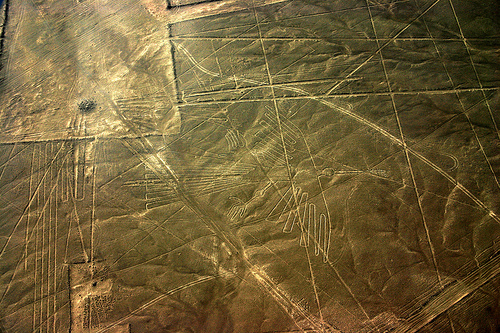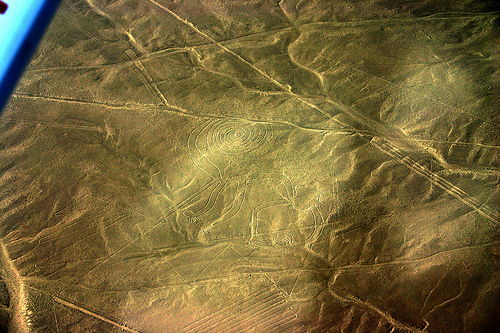 For nearly five decades, a scientific loner guarded a great labyrinth of lines on the desert floor near the small Peruvian town of Nazca. Day after day, until she was too elderly and too ill for such solitary work, Maria Reiche set out into the barren vastness with camera, compass, and papers, mapping thousands of straight lines and dozens of immense ground drawings inscribed on the desert floor more than 1500 years ago by the Nazca, masters of maize agriculture and irrigation.
For nearly five decades, a scientific loner guarded a great labyrinth of lines on the desert floor near the small Peruvian town of Nazca. Day after day, until she was too elderly and too ill for such solitary work, Maria Reiche set out into the barren vastness with camera, compass, and papers, mapping thousands of straight lines and dozens of immense ground drawings inscribed on the desert floor more than 1500 years ago by the Nazca, masters of maize agriculture and irrigation.
Reiche had studied mathematics as a young university student in Weimar Germany. She thought that the Nazca Lines formed a vast celestial calendar, an early scientific masterpiece akin to the calendar that Maya astronomers created and preserved in bark-paper books known as codices. Reiche believed the desert was a Nazca codex, and she brooked no intruders, no vandals on the lines. She paid for guards herself, and by the strength of her convictions she persuaded the Peruvian government to protect the lines. After her death in 1998, Alberto Fujimori, then president of Peru, talked of renaming them the Reiche Lines.
I was reminded of all this, when I came across a Reuters news story from Lima last week. Squatters recently invaded land next to the Nazca Lines, hammering together a makeshift settlement complete with pig corrals. The incursion now threatens delicate lines created long ago by clearing away small dark-colored pebbles from the lighter-colored desert floor. Archaeologists studying the Nazca culture are deeply worried: under Peruvian law, only a lengthy legal process can evict the squatters.
 Reiche would have been appalled, and this thought brought to mind a strange, almost otherworldly encounter I had with her before her death. I was on assignment at the time, researching an article on the Nazca and their justly celebrated lines. My archaeologist-companions on that trip were anxious and watchful: insurgents from the Shining Path, a terrorist organization, had swept down from the Andes a few weeks earlier, taking the town of Nazca before melting back into the mountains. Police checkpoints manned by frightened young recruits with machine guns had sprouted up every few miles, it seemed, along the Pan-American Highway.
Reiche would have been appalled, and this thought brought to mind a strange, almost otherworldly encounter I had with her before her death. I was on assignment at the time, researching an article on the Nazca and their justly celebrated lines. My archaeologist-companions on that trip were anxious and watchful: insurgents from the Shining Path, a terrorist organization, had swept down from the Andes a few weeks earlier, taking the town of Nazca before melting back into the mountains. Police checkpoints manned by frightened young recruits with machine guns had sprouted up every few miles, it seemed, along the Pan-American Highway.
As I discovered during the reporting trip, most archaeologists dismissed Reiche’s ideas about a giant Nazca codex: several major new studies —archaeological, ethnographic and astronomical–suggested that the lines once served as pilgrimage routes or pathways during annual rituals performed to please a rain god. This new research infuriated Reiche, to such a degree that she tried to bar access to the lines to her critics.
Knowing all of this, I wanted to interview Reiche, to hear what she had to say. At the age of 86, she was living in a small hotel suite in Nazca, under the care of her younger sister, Renate. I wrote to Renate, who promptly replied, suggesting a suitable time. I arrived, expecting to see Maria sitting comfortably in an armchair or perhaps even working at a desk cluttered with papers. Instead, I was ushered into a dark bedroom with drawn blinds. At first I could barely make out where Maria was.
I saw, however—to my alarm—that she was lying on a small bed, stretched out on her back. One thin white sheet covered her body, and as my eyes adjusted to the gloom, I realized that she had nothing on beneath it. She lay there nearly motionless, her skin drawn tightly over a skull-like face, her shoulders blistered from decades spent out in the desert sun. Only her eyes followed me. I had stumbled, it seemed, into the chamber of an oracle.
 We talked for half an hour or so. It was hard going: she had trouble speaking and I had difficulty understanding her. But when I finally tossed out a banal question about the ground drawings of animals—which one, I wondered, did she find the most fascinating—she instantly and clearly replied. “The monkey.” Of all the Nazca Lines, it is perhaps the most enigmatic—an exotic creature from afar, from the Amazon rainforest. And a creature that possesses only nine fingers, rather than the customary ten.
We talked for half an hour or so. It was hard going: she had trouble speaking and I had difficulty understanding her. But when I finally tossed out a banal question about the ground drawings of animals—which one, I wondered, did she find the most fascinating—she instantly and clearly replied. “The monkey.” Of all the Nazca Lines, it is perhaps the most enigmatic—an exotic creature from afar, from the Amazon rainforest. And a creature that possesses only nine fingers, rather than the customary ten.
Maria and I talked for a few more minutes, but she was clearly tiring. As I stood to go, she shot a hand out to me from under the sheet. And it was then I realized the extraordinary connection she had to the Nazca Lines, to the monkey in particular. Her hand had only four fingers.
I later learned that she suffered an accident as a young woman and lost a finger. And as time passed, I heard a great deal about her eccentricities, both personal and scientific. She stored all her maps and notes—a lifetime’s worth of research—under her bed. She was difficult, imperious to some, and for many years a serious impediment to scientific research on the Nazca Lines. But all this, I think, should be forgiven. During her lifetime, she protected the lines as no one has done since.
Archaeology would have been poorer, far poorer, without Maria Reiche.
Photos: Nazca Lines–The Condor by Bluelemur (Paul Williams), Nazca Lines– The Monkey by Bluelemur (Paul Williams); Maria Reiche (on right) and her sister Renate as children in Germany, courtesy Wikimedia Commons; Nazca Lines– The Monkey by Bluelemur (Paul Williams)
One thought on “The Oracle and the Monkey”
Comments are closed.